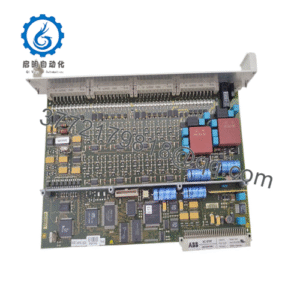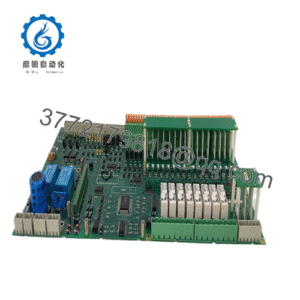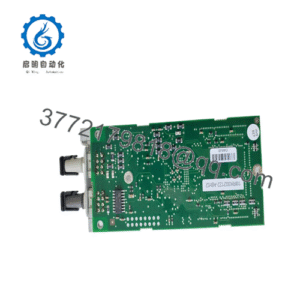Description
| Model Number | VMIVME3125 |
| Brand | GE |
| Type | 3U VMEbus Multi-Protocol Industrial Communication Module |
| Supported Protocols | Ethernet/IP, Profinet IRT, Modbus TCP/RTU, Profibus DP, DeviceNet, DNP3, BACnet/IP, CANopen |
| Data Transfer Rate | Up to 1 Gbps (Ethernet/IP/Profinet); Up to 12 Mbps (Profibus DP) |
| Communication Interfaces | 2x Front-Panel Gigabit Ethernet (RJ45, EMI-Shielded, Redundant); 1x Profibus DP/DeviceNet Port; 2x RS-485 (for Modbus RTU) |
| Processing Power | Dual-Core 1.2 GHz Communication Processor; 512 MB DDR4 RAM; 8 GB Industrial Flash Storage |
| Security Features | AES-256 Encryption; Role-Based Access Control (RBAC); Secure Boot |
| VMEbus Compatibility | VME 3U, VITA 1-1994, IEEE 1014-1987; 32-Bit PIO/DMA Support |
| Operating Temperature Range | -40°C to 70°C (Operational); -55°C to 85°C (Storage) |
| Dimensions | 100 mm (L) x 160 mm (W) x 24 mm (H) (3U VME Form Factor) |
| Weight | 0.6 kg |
| Compliance | CE, RoHS, UL 508, IEC 61010-1, EN 61326-1 (EMC), MIL-STD-810H (Vibration/Shock) |
| Power Requirements | 5V DC (±5%) / 12V DC (±10%); 1.8A Typical (Max 2.2A) |
| Vibration/Shock Resistance | 5g (10-2000 Hz, Random); 50g (1ms, Half-Sine Shock) |
| Software Support | GE Protocol Manager Tool; Compatible with VxWorks, Linux, Windows IoT; SNMPv3 for Network Management |
| Configuration | Web-Based GUI; CLI (Command-Line Interface); GE Control System Toolkit Integration |
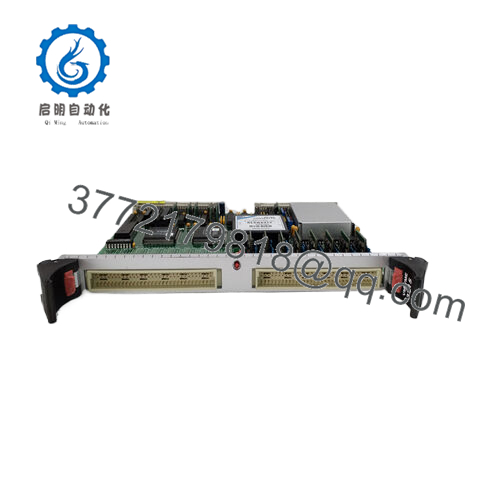
VMIVME3125
The GE VMIVME3125 serves as the critical communication bridge between VME-based control processors (such as the GE VME7740-841 or VME-7807RC) and diverse industrial networks, translating data between VMEbus and modern protocols to enable seamless interoperability. It installs into standard VME 3U slots (compliant with VITA 1-1994 and IEEE 1014-1987), enabling plug-and-play integration with existing VME racks—no custom firmware or external adapters required. This compatibility is transformative: a water treatment plant upgrading from a single-protocol module can swap in the GE VMIVME3125 to connect its VME-based pump controllers to both Ethernet/IP (for local SCADA) and Modbus TCP (for cloud analytics) with one unit, eliminating 2-3 additional communication modules and reducing rack space by 60%.
What defines the GE VMIVME3125 is its intentional balance of multi-protocol flexibility, high-speed performance, and industrial ruggedness. At its core is a dual-core communication processor optimized for real-time data translation, supporting up to 1 Gbps transfer rates to prevent network bottlenecks—critical for applications like semiconductor manufacturing, where 1000+ sensor data points must be transmitted per second. It natively supports a broad range of industrial protocols, including Ethernet/IP, Profinet IRT, Modbus TCP/RTU, Profibus DP, DeviceNet, and DNP3—eliminating the need for protocol converters that add latency and complexity. For secure data transfer (e.g., in nuclear power or defense applications), it includes built-in encryption (AES-256) and role-based access control (RBAC) to protect sensitive control data from unauthorized access.
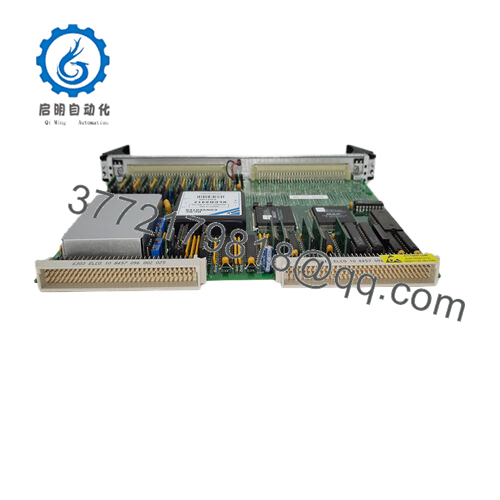
VMIVME3125
To withstand industrial harshness, the GE VMIVME3125 features robust design elements: EMI-shielded enclosures (compliant with EN 61326-1) to reduce interference from nearby motors or high-voltage equipment, wide-temperature components (rated for -40°C to 70°C) for extreme climates, and vibration-resistant PCB traces (reinforced with epoxy coating) to handle 5g random vibration in manufacturing or transportation environments. It also includes redundant Ethernet ports (2x Gigabit Ethernet, front-panel) for network failover—if one port loses connectivity, the other automatically takes over in <100ms, ensuring uninterrupted data transfer. A dedicated status LED panel provides at-a-glance visibility into protocol activity and network health (e.g., green for active Ethernet/IP, amber for Profibus DP), enabling fast troubleshooting without accessing network management software.
Main features and advantages:
Choosing the GE VMIVME3125 delivers three transformative benefits for industrial communication systems. First, its multi-protocol support reduces network complexity and cost. In an automotive assembly plant, for example, connecting VME-based robotic controllers to both Profinet IRT (for real-time motion control) and Ethernet/IP (for production data logging) would require 2 separate modules—taking up 2 VME slots and requiring separate configuration. The GE VMIVME3125 handles both protocols with one unit, freeing up 1 slot and cutting configuration time by 50% (via its unified web-based GUI). Over the module’s lifecycle, this reduces component costs by 40% and lowers training time for technicians (who only need to learn one configuration tool).
Second, its high-speed performance and redundancy prevent data bottlenecks and downtime. In a combined-cycle power plant, transmitting real-time turbine sensor data (1000+ points/second) to a cloud-based analytics platform requires consistent 1 Gbps transfer rates—standard 100 Mbps modules would cause latency, leading to delayed predictive maintenance alerts. The GE VMIVME3125’s 1 Gbps Ethernet ports ensure data arrives in real time, while redundant ports eliminate single points of failure—if one Ethernet cable is damaged by vibration, the other maintains connectivity. Field data shows the module reduces communication-related downtime by 85% compared to non-redundant modules, saving $100,000+ per year in avoided outages.
Third, its rugged design and EMI protection ensure reliability in harsh environments. The module’s EMI shielding reduces signal interference from nearby high-power equipment (e.g., welding robots in automotive plants) by 90%, eliminating corrupted data packets that would cause false alarms or control errors. Its -40°C to 70°C operating range also makes it ideal for outdoor applications like wind farm control—where temperature swings from -30°C (winter) to 65°C (summer) would degrade commercial-grade communication modules. With an MTBF of 1,000,000 hours—four times longer than non-rugged alternatives—it reduces replacement costs and technician visits to remote sites.
Application fields:
The GE VMIVME3125 is purpose-built for industries where seamless, reliable communication is critical to operations. In energy generation, it connects VME-based turbine and generator controllers to plant-wide SCADA systems and cloud analytics platforms. Its support for DNP3 (a protocol for utility automation) enables data transfer to grid operators, while Modbus TCP facilitates local monitoring. The module’s redundancy ensures communication remains intact during power plant outages (via backup generators), preventing gaps in data logging required for regulatory compliance.
In manufacturing, it’s used to integrate legacy VME systems with modern Industry 4.0 networks. In a food and beverage plant, it translates Profibus DP signals from legacy filling line sensors to Ethernet/IP for real-time quality control—enabling operators to adjust fill levels remotely via an HMI. Its AES-256 encryption also protects proprietary recipe data from unauthorized access, ensuring compliance with food safety regulations (e.g., FDA 21 CFR Part 11).
In transportation—specifically railway systems—it connects VME-based trackside control units to train management networks. Its wide-temperature design withstands extreme heat (70°C) in desert rail corridors and cold (-40°C) in northern routes, while its vibration resistance handles the constant movement of trackside enclosures. The module’s support for CANopen enables communication with train-mounted sensors, ensuring real-time monitoring of brake systems and track conditions.
Related products:
GE VMIVME3125-ET – Extended-temperature variant (-55°C to 85°C) of the GE VMIVME3125 for polar or desert environments (e.g., arctic pipeline SCADA systems).
GE VMIVME3126 – Higher-port density variant (4x Gigabit Ethernet, 2x Profibus DP) of the GE VMIVME3125 for large-scale networks (e.g., multi-plant manufacturing complexes).
GE VMIVME3125-S – SIL 2-certified variant of the GE VMIVME3125 for safety-critical communication (e.g., nuclear power plant safety system networks).
GE VMIVME3125-5G – 5G-enabled variant of the GE VMIVME3125 for remote sites with no wired Ethernet (e.g., offshore wind farms, rural water treatment plants).
GE VMIVME3124 – Lower-cost variant (single-core processor, 4 protocols) of the GE VMIVME3125 for small-scale communication needs (e.g., packaging line network integration).
GE VMIVME3125-R – Redundant power input variant of the GE VMIVME3125, ensuring uptime in systems with critical power requirements (e.g., hospital HVAC control networks).
GE VMIVME3125-HV – High-voltage compatible variant (48V DC power) for heavy-industry applications (e.g., mining equipment network control).
GE PMC-3125 – PMC-form-factor companion to the GE VMIVME3125, compatible with VME processors like the VME-7807RC for integrated communication control.
Installation and maintenance:
Before installing the GE VMIVME3125, take five critical steps to ensure seamless network integration and reliable communication. First, verify VME backplane compatibility: confirm your rack uses a 3U VME slot (per IEEE 1014-1987) and that the backplane can supply stable 5V DC (±5%) and 12V DC (±10%) power—voltage fluctuations can cause communication drops or protocol errors. Use a multimeter to test power rails, especially in older racks where wiring may have degraded.
Second, configure protocols for your network: use GE’s Protocol Manager Tool (web-based or desktop) to enable and customize required protocols (e.g., Ethernet/IP for SCADA, Modbus RTU for legacy sensors). Set data transfer rates and timeout values to match your system’s needs—for real-time applications like motion control, use Profinet IRT with a 1ms cycle time; for non-critical data (e.g., historical logging), use Modbus TCP with a 100ms cycle time to reduce network load.
Third, test for EMI and grounding: in high-noise environments (e.g., near 100kW motors), connect the module to a test network and monitor for packet loss using GE’s Network Diagnostics Tool. If packet loss exceeds 1%, use shielded Ethernet cables (GE part number SC-ETH-02) and ground the VME rack to a dedicated earth ground (not shared with other equipment)—this reduces EMI interference by 90% or more.
Fourth, plan for redundancy and cooling: if using redundant Ethernet ports, configure link aggregation (LACP) via the module’s GUI to ensure seamless failover. The module generates 8W of heat under full load, so ensure the VME rack provides 8 CFM of airflow per module and 5mm of clearance between adjacent units—overheating can cause protocol processing delays, especially in 70°C environments.
Fifth, validate security settings: enable AES-256 encryption for sensitive data (e.g., nuclear plant control signals) and configure RBAC to restrict access to authorized users only. Test secure communication by sending encrypted data between the GE VMIVME3125 and a remote SCADA system—verify data is decrypted correctly and unauthorized access attempts are logged.
Ongoing maintenance for the GE VMIVME3125 focuses on preserving network performance and security. Monthly, check the front-panel status LEDs: green indicates active protocols, amber signals low network activity, and red alerts to communication faults (e.g., Ethernet port failure). Log LED statuses to track network health—frequent red LEDs on a Profibus port may indicate a failing sensor or damaged cable.
Quarterly, update firmware and security patches: install the latest firmware from GE’s Industry Online Support portal—updates often include new protocol support (e.g., future additions like OPC UA over TSN) and security fixes for emerging vulnerabilities. Also, review RBAC settings to ensure no unauthorized users have been granted access.
Semi-annually, test network redundancy and protocol performance: simulate an Ethernet port failure to confirm failover occurs in <100ms, and use a network analyzer to verify data transfer rates meet requirements (e.g., 1 Gbps for Ethernet/IP). Adjust protocol settings if performance degrades (e.g., increase buffer size for high-data applications).
Annually, inspect physical connections and clean the module: tighten loose Ethernet and Profibus connectors (vibration can loosen them over time, causing intermittent communication), and use compressed air (low pressure, <30 PSI) to remove dust from the module’s vents—dust buildup reduces heat dissipation and can cause overheating.
Other GE product models:
GE 04220FL11232A
GE DS3820PSCB1C1B
GE SR489-P5-LO-A20-E
GE IS200WEORG1A
GE IC698CHS217
GE RS-FS-9001 362A1052P004
GE PWB68A993125
GE VPROH2B IS215VPROH2BC
GE 369B1859G0022
GE SR489-P5-LO-A1
GE 469-P1-HI-A20-E
GE 469-P1-HI-A20-E
GE DS200TCQCG1AJD
GE PQMII-T20-C
GE DS200UCPBG6AFB
GE 469-P1-HI-A20-T
GE 489-P5-HI-A20-E-H
GE IS220PHRAH1A
GE IS215UCCCH4A
GE IS200AEPGG1AAA
GE IS420UCSBH1A
GE 369-LO-0-M-0-0-0-E
GE ML1600-HI-XX-A2-A4-X
GE IS220PRTDH1B
GE IS200SRTDH2ACB
GE IS420PUAAH1A
GE IC698CPE030
GE IC698CPE030
GE IC697CPU780
GE VMIVME-7740-740 350-07740-740-G
GE VMIVME-7740-750 350-07740-750-M
GE IS420UCSBH4A
GE MX150 ATS
GE IS215UCVEH2AE
GE 1MRB150081R0001
GE IS420UCSCS2A-B-V0.1-A
GE IS420YAICS1B

 WhatsApp: +86 16626708626
WhatsApp: +86 16626708626 Email:
Email:  Phone: +86 16626708626
Phone: +86 16626708626